12 Best Lenses for Real Estate Photography in 2025
You need to be very good at both technical details and artistic flair to be good at real estate photos. The right lens can make a small room feel more open or a simple house look like a mansion. Good pictures are a must because buyers are depending more and more on online listings to decide what to buy. With suggestions for Canon, Nikon, Sony, and other camera systems, as well as useful tips on how to choose the best lens for your needs, this guide goes into great detail about the best lenses for real estate photography.
Table of Contents
Why Lenses Matter in Real Estate Photography
How a house looks to potential sellers is controlled by the lens, which is the most important part of your camera camera setup. Views can be distorted, places can look smaller, or important details may not be captured if you choose the wrong lens. Finding the right lens is very important for these reasons:
- A wide view: When you’re taking pictures of real estate, you often have to work in small spaces. To get pictures of whole rooms or large exteriors, you need wide-angle lenses.
- When you use barrel distortion, straight lines, like walls or windows, can be curved. This can give you the wrong idea about how the property is laid out.
- Sharpness Across the Frame: The picture needs to be clear all the way around. These things are clear because buyers want to see things like the wood lines on floors or the textures on tables.
- When there isn’t much light, lenses with fast apertures work best. This is so because many shots depend on natural light or very minimal synthetic light.
- It saves time: Since you can use the same lens indoors and outside, so you don’t have to change gears during a shot.
Sort real estate images by camera system, price, and use to help you choose the ideal lens.
Key Considerations for Choosing a Real Estate Lens
There are technical and useful things that affect lens choice that you should know about before getting into specific lens suggestions:
- Wide focal lengths (10-16mm on APS-C and 14-24mm on full-frame) are great for taking pictures of whole rooms inside. 24–35mm focal lengths give you a more realistic view when shooting outside.
- Open-hole size: Big apertures (f/2.8 or f/4) work best in dim light, while small apertures (f/4.5 to 5.6) save money and work well in bright places.
- Not the Same In the case of full-frame and APS-C cameras: Full-frame cameras can see more and work better in low light, but APS-C cameras with crop-sensor lenses are smaller and less expensive.
- The lines stay straight with lenses that have low barrel distortion or rectilinear designs. This is important for building precision.
- Build and Autofocus: For quick shoots and days spent outside, fast, quiet autofocus and strong construction are helpful.
- Lenses for beginners start at about $300, but lenses for professionals can cost over $2,000*.
Best Lenses for Real Estate Photography
1. Canon EF 16-35mm f/2.8L III USM
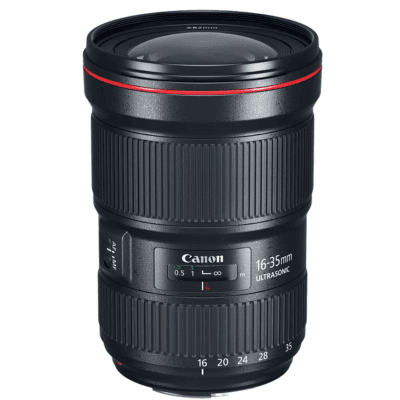
- Price: $1,999.00
- Overview: Professional real estate shooters use Canon’s best wide-angle zoom lens all the time. As the lens stays at f/2.8, the camera does a great job in low light thanks to its 16-35mm focal range.
- Key Features:
- As wide as 16mm, it still has very good sharpness and very little distortion.
- Built-in the L-series and sealed against the weather for outdoor use.
- Both stills and video can be autofocused quickly and quietly with an Ultrasonic Motor (USM).
- If you use an EF-to-RF adapter, it works with the Canon EOS R5, R6, or 5D Mark IV.
- Pros:
- Different types of properties can use this focus range.
- Great picture quality, perfect for high-end ads.
- Easy to use and lasts a long time.
- Cons:
- A lot of money for artists and newcomers.
- One-and-a-half pounds heavy.
- Best for: Professionals who need to shoot high-end properties and won’t settle for less than the best quality.
2. Canon EF-S 10-18mm f/4.5-5.6 IS STM
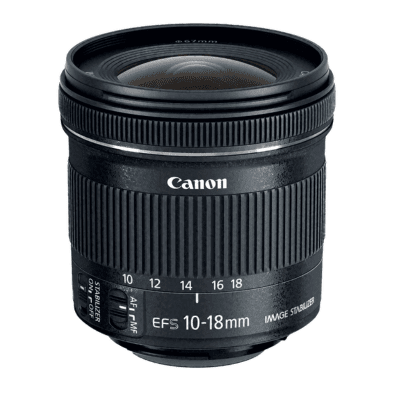
- Price: $300
- Overview: The 16-28mm comparable focal length of this inexpensive lens makes it a top choice for Canon APS-C users. There is picture stabilization so that you can shoot handheld, and it’s not too expensive.
- Key Features:
- Perfect for places with limited room because it has an extremely wide field of view.
- Image Stabilizer (IS) for clear pictures in low light.
- Autofocus that is smooth and quiet thanks to the Stepping Motor (STM). This is great for walking you through video tutorials.
- Pros:
- So cheap for newbies.
- Small enough to carry around.
- For the price, it’s sharp enough.
- Cons:
- As the lens changes, it becomes harder to see in low light.
- With 10mm, the edges are a little different.
- Best for: Those using a Canon EOS 90D, Rebel T8i, or another camera should find this helpful.
3. Canon RF 15-35mm f/2.8L IS USM
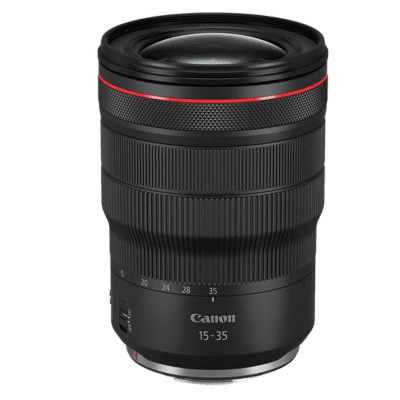
- Price: $2,299.00
- Overview: This lens is made for Canon’s mirrorless RF mount and starts at 15mm, which is a little bigger than the EF 16-35mm. Mirrorless shooters will love how full it is of current optics and stabilization.
- Key Features:
- Visual Stabilizer with 5 stops for shooting steady.
- For speed and accuracy, Nano USM focuses.
- Bright windows with new treatments have less flare and ghosting.
- Pros:
- For Canon EOS R cameras, it works best.
- Smooth focus changes make it great for video.
- For outdoor shoots it’s weatherproof.
- The bad news is:
- Extraordinary price.
- It’s harder for older DSLRs to work with RF mounts.
- Best for: People who want the best performance.
For real estate photography that needs to be sharp and last a long time, Nikon’s FX (full-frame) and DX (APS-C) lenses are great choices.
4. Nikon AF-S NIKKOR 14-24mm f/2.8G ED
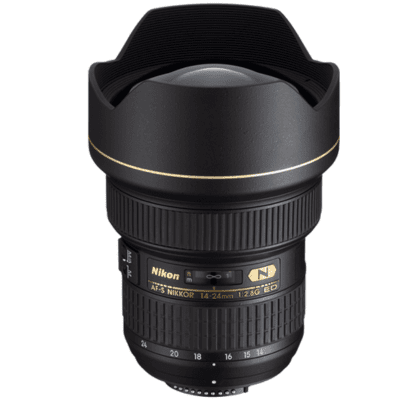
- Price: $1,099.95
- Overview: Professional Nikon users rely on this ultra-wide zoom, which has a 14-24mm range that lets them take clear pictures of both large interiors and exteriors of buildings.
- Key Features:
- Very low dispersion (ED) lens gives you sharp images from edge to edge.
- F/2.8 opening that stays the same for great performance in low light.
- Build that is strong and weatherproof for outdoor use.
- You can use an FTZ connector to connect it to a Nikon Z7 II, Z6 II, or D850.
- Pros:
- High-end homes with the clearest views possible.
- To get stunning views, use the 14mm focal length.
- Heavy-duty enough to be used often.
- Cons:
- It is big and heavy (2.2 pounds).
- With a bulbous front part, there is no filter thread.
- Best for: Professionals who care most about picture quality on Nikon full-frame systems and want the best.
5. Nikon AF-P DX NIKKOR 10-20mm f/4.5-5.6G VR
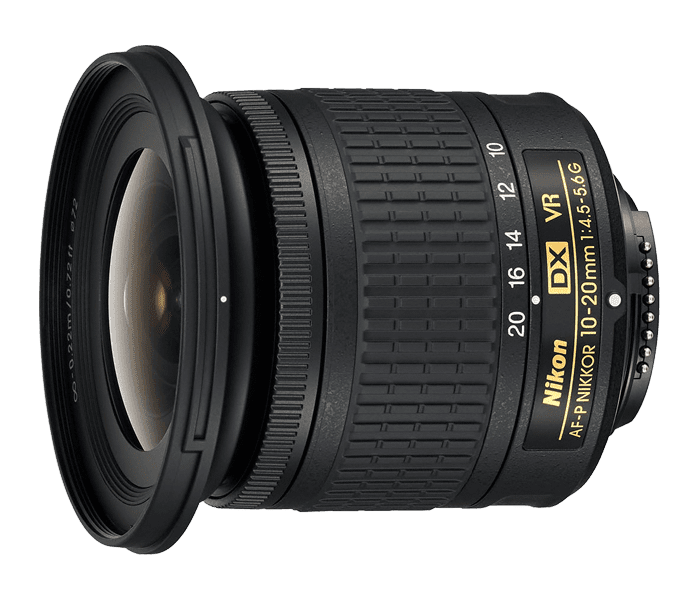
- Price: $279.95
- Overview: This cheap lens has a focal length of 15 to 30 mm on Nikon DX cameras, which makes it perfect for taking pictures inside. It’s easier to shoot mobile with Vibration Reduction (VR).
- Key Features:
- At 8.2 oz, it’s featherweight and great for shoots that last all day.
- A fast and quiet focusing system called AF-P.
- VR can stabilize motion up to 3.5 stops.
- Pros:
- Good for beginners on a budget.
- Small enough to carry around.
- It’s not too expensive for what you get.
- Cons:
- When there isn’t much light, a variable angle can’t help.
- It feels less high-end when it’s made of plastic.
- Best for: Professionals who using Nikon D5600, D7500, or similar DX cameras.
6. Nikon Z 14-30mm f/4 S
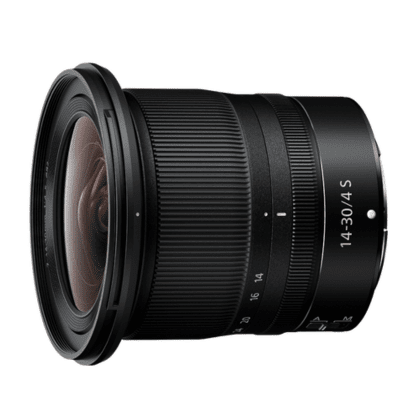
- Price: $1,149.95
- Overview: Made for Nikon’s Z-series mirrorless cameras, this lens boasts a 14–30mm range with a fixed f/4 aperture. It’s smaller than the 14–24mm f/2.8, and you may filter it.
- Key Features:
- The retractable form enhances portability.
- There is no dust or smudges on the fluorine layer.
- Manual focus or brightness can be changed with a control ring.
- Pros:
- Just 1.07 pounds, it’s not heavy.
- Compatible with ND or polarizer filters of any kind.
- Optics that are clear for people who use the Z6 II or Z7 II.
- Cons:
- Not as fast as f/2.8 lenses, with an opening of f/4.
- The 14–24mm wide end is more dynamic.
- Best for: Nikon mirrorless people who want a quality and portability?
With its small mirrorless bodies and advanced autofocus, Sony’s E-mount system is a choice for real estate work.
7. Sony FE 12-24mm f/4 G
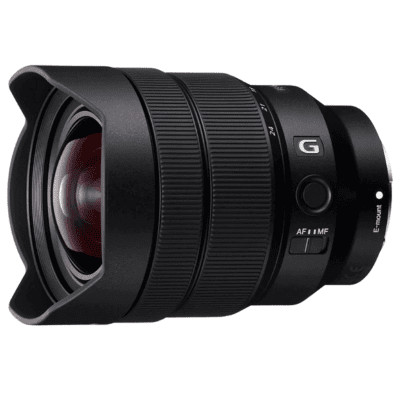
- Price: $2,299.99
- Overview: When used with Sony full-frame cameras like the A7 IV or A7R V, this ultra-wide lens’s 12mm focal length makes it great for shocking interior shots.
- Key Features:
- This ultra-wide lens has very little distortion.
- Autofocus is quick and quiet with Direct Drive SSM.
- One-and-a-half pounds makes it very light, perfect for shooting with one hand.
- Pros:
- The Sony full-frame camera with the widest zoom.
- A great choice for high-end homes with large rooms.
- Wide-angle zoom that is small.
- Cons:
- The shape of the lens means that there is no filter thread.
- For non-professionals, it’s too expensive.
- Best for: Sony shooters who need an extremely wide view.
8. Sony E 10-18mm f/4 OSS
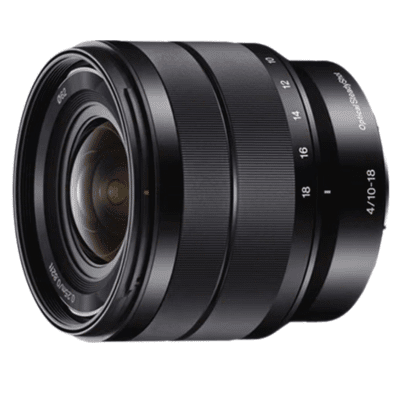
- Price: $900
- Overview: This lens has an equivalent focal length of 15–27mm and an Optical SteadyShot (OSS) for snapping sharp pictures while holding the camera. It works with Sony APS-C cameras (A6600, ZV-E10).
- Key Features:
- For even exposure, the aperture stays at f/4.
- For outside shots with depth, use smooth bokeh.
- The 8-ounce size makes it easy to carry.
- Pros:
- Small rooms and the outside can both use it.
- When there isn’t much light, stabilization helps.
- Videos with reliable focus.
- Cons:
- Some APS-C rivals are less expensive.
- At 10mm, there is some blur.
- Best for: APS-C Sony users who want to find a good balance between quality and price.
9. Sony FE 16-35mm f/2.8 GM
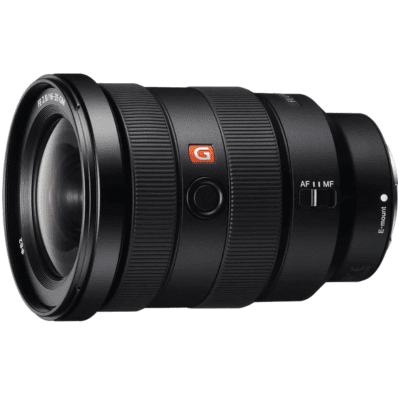
- Price: $1,899.99
- Overview: The Sony G Master lens is a high-end lens with a 16-35mm range and a fast f/2.8 aperture that makes photos of high-end real estate look beautiful.
- Key Features:
- Outstanding clarity from G Master optics.
- Fast-focusing thanks to two DDSSM motors.
- Design that keeps dust and moisture out.
- Pros:
- Highly impressive in low light.
- Works great for videos that don’t need detailed breathing.
- High-quality construction to last.
- Cons:
- For amateur shooters, it’s too expensive.
- Not quite as light as f/4 options.
- Best for: Professional Sony photographers who want to take pictures of high-end homes.
10. Fujifilm XF 10-24mm f/4 R OIS WR
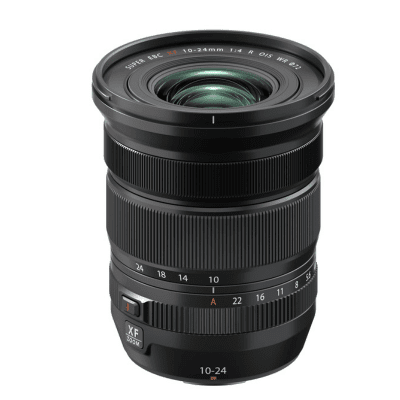
- Price: $999.95
- Overview: Its f/3.5 aperture is quick, and its focal length is similar—between 15 and 30mm. Working with Canon EF-S, Nikon DX, and other APS-C systems, this third-party lens provides.
- Key Features:
- Holds f/3.5 steady for better performance in low light.
- Quick autofocus thanks to the Hyper-Sonic Motor (HSM).
- Made of solid materials and coated with many layers.
- Pros:
- Inexpensive for people who use more than one brand.
- Focusing range that is flexible.
- For the price, it’s pretty sharp.
- Cons:
- An uneven color at the edges.
- Seals out the weather.
- Best for: APS-C camera owners who want to save money.
11. Canon TS-E 17mm f/4L
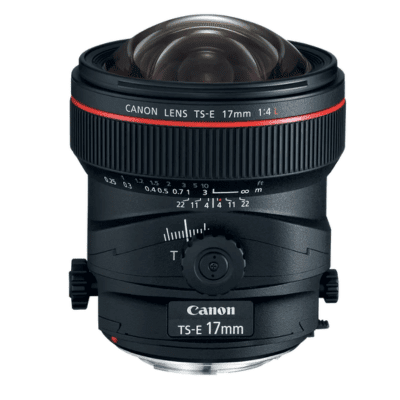
- Price: $2,149.00
- Overview: In short, Fujifilm’s X-series lenses are great for people who use the X-T5 or X-S20 because they have a similar focal length of 15–36mm and optical stabilization.
- Key Features:
- For uniformity, keep the aperture at f/4.
- Suitable for outdoor shoots in all kinds of weather.
- Handheld shots are possible with the optical image stabilizer.
- Pros:
- Optics of the highest quality with few flaws.
- Long-lasting in any setting.
- Really helpful for Fujifilm’s color science.
- Cons:
- An APS-C lens costs a lot.
- Fewer pixels, at the very least.
- Best for: People who shoot Fujifilm and want a good wide-angle zoom…
When it comes to architecture and high-end interiors, tilt-shift lenses are perfect because they let you finetune the view and depth of field.
12. Nikon PC NIKKOR 19mm f/4E ED
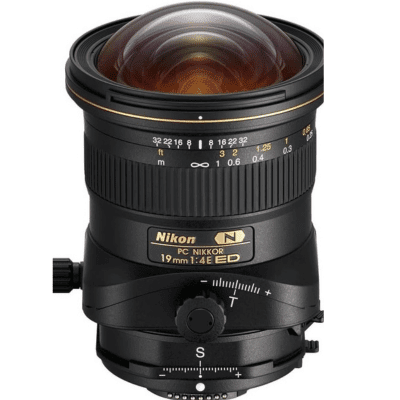
- Price: $2,419.00
- Overview: The Nikon tilt-shift lens has a 19mm focal length and advanced tilt, shift, and rotation controls that let you get very exact control over the perspective.
- Key Features:
- Just the right amount of blurring and vignetting.
- Better picture clarity thanks to ED glass.
- Uses an FTZ adapter to work with Nikon Z cameras.
- Pros:
- Excellent for big rooms inside and outside.
- Extraordinary vision for important work.
- Build that is strong.
- Cons:
- Cost a lot.
- Skill is needed to focus by hand.
- Best for: Nikon experts who shoot high-end properties.
Useful Advice for Photographing Real Estate
More than just picking out the right lens is needed. So you can get the best results, here are some tips:
- Do not forget to use a Tripod. This will enable you to obtain crisp images, particularly in low light conditions or using HDR. Among strong choices are the Vanguard Alta Pro and the Manfrotto 190X.
- To get the right mix between bright windows and dark rooms, shoot HDR and bracket your exposures. In Adobe Lightroom or Aurora HDR, you can merge photos after they have been processed.
- Even the best lenses can have some distortion, so make sure the distortion is right. Fix lines in Lightroom or Photoshop by using the Lens Correction or Transform tools.
- Natural light is very useful. For bright, even lighting, shoot during the golden hour. Smooth out harsh shadows with mirrors or diffusers.
- Fill in the Gaps: If the inside of a room is dark, add artificial light with speedlights or LED screens (like the Godox AD200 or Nanlite LitoLite).
- When you’re outside, a filter cuts down on glare and improves the contrast between the sky and the background. There should be a filter hole on your lens.
- Using tools like Luminar Neo or DxO PhotoLab helps one correct brightness, add colors, and eliminate undesired features.
- Shallow depth of field results from shooting at f/8 to f/11; hence everything from the center to the background stays in focus.
- Real estate agents will help you declutter and arrange the area so that rooms seem larger and more inviting.
More Helpful Advice on Gear
- A Canon EOS R5 (45MP), Nikon Z7 II (46MP), or Sony A7R V (61MP) camera and lens should be used when you take pictures.
- Another name for this gimbal is the DJI Ronin-SC. It can be used to keep video footage steady for property tours.
- Drone for the Sky: With a drone like the DJI Mini 4 Pro, you can take beautiful pictures of your yard and outside. Real estate ads for high-end homes often need these shots.
- Cleaning Kit for Lenses: To keep lenses clean in bright light, use a kit like the Zeiss Cleaning Kit to keep them clear.
Avoid these common mistakes.
- Too many ultra-wide lenses: For buyers, rooms that look too big can be caused by extreme focal lengths.
- Failure to Notice Distortion: Always look for and fix crooked lines after processing.
- Low-Light Handheld Shooting: Handheld shots that aren’t stabilized could be blurry. Be careful when you raise the ISO or use a tripod.
- Do not use harsh daytime light on the outside of your building or too little light inside without adding more lights.
- When you don’t pay attention to composition, you should use the rule of thirds, line up your vertical lines, and keep your foregrounds clear.
The End
Your camera system, budget, and shooting style will all affect which lens is best for real estate photos. The Excellent lenses for Canon users include EF 16-35mm f/2.8L III or RF 15-35mm f/2.8L. Additionally, a fantastic option for APS-C is the EF-S 10-18mm. Perfect options for alternative configurations are the Fujifilm XF 10-24mm and the Sigma 10-20mm. Greater power will be yours with tilt-shift lenses like the Canon TS-E 17mm or Nikon PC 19mm. If you have a decent camera and adequate lighting and know how to edit them later on, you can create images that people would wish to buy. You can take shots that not only show off properties but also help close deals if you spend money on the right tools and know-how.
